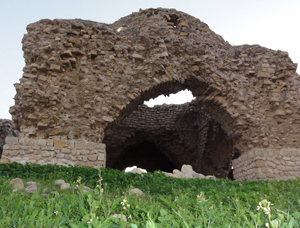Farashband facts for kids
Quick facts for kids
Farashband
Persian: فراشبند
|
|
|---|---|
|
City
|
|

The old fire temple
|
|
| Country | Iran |
| Province | Fars |
| County | Farashband |
| District | Central |
| Elevation | 775 m (2,543 ft) |
| Population
(2016)
|
|
| • Total | 20,320 |
| Time zone | UTC+3:30 (IRST) |
Farashband (Persian: فراشبند) is a city in Iran. It is located in the Fars Province. Farashband is the main city of both Farashband County and its Central District. This city sits at an altitude of about 775 meters (2,543 feet) above sea level. It is a place with a long history and a unique culture.
Contents
Farashband's Population
How Many People Live Here?
Farashband has been growing steadily! In 2006, about 17,142 people lived here. This number was counted in 3,762 households. By 2011, the population grew to 18,492 people. They lived in 4,700 households. The latest count in 2016 showed that 20,320 people call Farashband home. These people lived in 5,717 households.
Discovering Farashband
Where is Farashband?
Farashband is located in the western part of Fars Province. It is about 172 kilometers (107 miles) west of Shiraz. The city shares borders with several other areas. To the north, it is next to Kazeroon. To the west, you will find Booshehr. To the south, it borders Lar. To the east, it is close to Ghir-Karzin and Firoozabad.
Climate and Nature
The city is about 750 meters (2,460 feet) above sea level. Farashband has a hot and dry climate. The average temperature throughout the year is around 25 °C (77 °F). The area covers about 59,455 hectares (146,916 acres).
Local Economy and Products
Farashband's economy mainly relies on farming and gardening. Many citrus orchards grow here. Palm trees are also very important, especially for a type of date called Ghasb Zahedi. These farms create beautiful scenery. They also attract visitors to the region. The city also has natural gas resources. Carpet weaving is another important part of the economy.
Handicrafts and Nomads
The region is home to many nomads. These are people who move from place to place. They create a special atmosphere in the area. They are known for their beautiful hand-woven items. These include Gabbeh, Glim (also known as Kilim), and Jajim. These items are often sold to tourists.
Languages and Tribes
The people of Farashband speak a mix of languages. These include ancient Persian, Lorrish (like Bakhtiari-Laky), Mamassani, and Kohkilloyehee. Some villages have their own unique words and phrases. The Qashqai language is also spoken here.
Several different tribes live in Farashband. These include Lorr, Tork, and Pars. Many nomads live in the pastures for 7–8 months each year. About 25,000 nomads make their home here. The Qashqai people include tribes like Amale, Shesh Bluki, Farsimadan, and Ardkapan. There are also different Lorr tribes. These include Nobenjani, Ghalesefidi, Bakhtiari, Sadat Fahluanisarruee, and Dashti. The rest of the population belongs to the Tajik tribe.
Farashband's Ancient History
A City with a Long Past
Farashband has a history that goes back about 1,600 years. Many old buildings and sites show this long past. Even though it is very old, it is sometimes considered younger than other cities. This is because there are not many written historical records. People have always believed that the city was founded during the time of Bahram Gur. He was a ruler during the Sasanian Empire. Many buildings with the chahartaq architecture style support this idea.
Important Historical Sites
Farashband has several interesting archaeological sites. These are places where old remains have been found:
- Chahar Tagh Gangi: This is a four-arched building from the Sasanian period.
- Farrashband's Bath: An old bathhouse.
- Chahar Tagh Naghare Khaneh: Another four-arched structure.
- Chahar Tagh Rahni: A four-arched building.
- Chahar Tagh Gonbad: A four-arched dome structure.
- Wind Mill: An old windmill.
- Goldsmiths Ghallat: This site is from the Afsharian period.
Tourism and Religious Sites
Farashband offers many places for visitors to see. There are also many religious sites. Some of these include:
- Konarmalek Four-Arched, Tol Gangi Four-Arched, Zayerhosseini Four-Arched, Khormayak, Gonbad, Ghanatbagh, and Rahni Four-Arched.
- Natural springs like Barmefarhad Spring and Abpa Spring.
- Mountain Park.
- Several holy shrines (places of worship):
- Emamzade Holy Shrine (Agham Shahid)
- Shahzade Tayyeb Holy Shrine (Zeinalabedin)
- Shahaziz Holy Shrine (To Baghi)
- Seyyed Ahmad Holy Shrine
- Seyyed Mohammad Holy Shrine
- Alibakhsi
- Pirgheib
- Mohamnad (Khaniak)
- Agha Mohammad (Khorab)
- Amir Shahsavar (Dezhgah)
- Abbolghasem (Dehram) Holy Shrines


